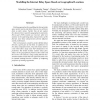Free Online Productivity Tools
i2Speak
i2Symbol
i2OCR
iTex2Img
iWeb2Print
iWeb2Shot
i2Type
iPdf2Split
iPdf2Merge
i2Bopomofo
i2Arabic
i2Style
i2Image
i2PDF
iLatex2Rtf
Sci2ools
PDP
2009
IEEE
2009
IEEE
Modelling the Internet Delay Space Based on Geographical Locations
Existing approaches for modelling the Internet delay space predict end-to-end delays between two arbitrary hosts as static values. Further, they do not capture the characteristics caused by geographical constraints. Peer-to-peer (P2P) systems are, however, often very sensitive to the underlying delay characteristics of the Internet, since these characteristics directly influence system performance. This work proposes a model to predict lifelike delays between a given pair of end hosts. In addition to its low delay computation time, it has only linear memory costs which allows large scale P2P simulations to be performed. The model includes realistic delay jitter, subject to the geographical position of the sender and the receiver. Our analysis, using existing Internet measurement studies reveals that our approach seems to be an optimal tradeoff between a number of conflicting properties of existing approaches.
Delay Characteristics | Internet Delay Space | Parallel Computing | PDP 2009 | Realistic Delay Jitter |
| Added | 19 May 2010 |
| Updated | 19 May 2010 |
| Type | Conference |
| Year | 2009 |
| Where | PDP |
| Authors | Sebastian Kaune, Konstantin Pussep, Christof Leng, Aleksandra Kovacevic, Gareth Tyson, Ralf Steinmetz |
Comments (0)

